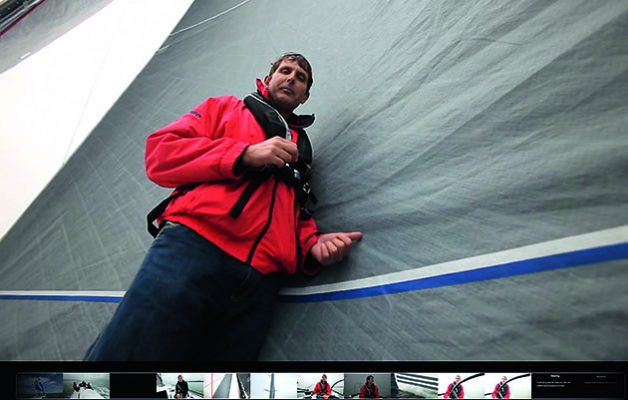In part 7 of our series, Pip Hare outlines the delicate interplay of trim, speed and course involved in light airs sailing. Solo sailor Brian Thompson adds his own thoughts
![]()
We all know the frustration of trying to sail in light airs – it can be hard to resist firing up the engine. Yet most of us love to trim sails to tease the last quarter of a knot from our boats and light airs is when this matters most. In this feature and video we offer some tips to keep the boat moving with your morale intact.
Upwind
In light airs upwind it’s all about power and momentum. Trim the sails for maximum drive even through swell or chop.
Jib
Ease the backstay to increase the sag of the forestay and give a deeper, more powerful shape to the jib. Make sure the draught of the sail is kept just forward of centre – this will need a fairly eased halyard.
Upwind trim in light airs requires less sheet tension than normal; move the jib car slightly forward then pull on the sheet, being careful not to hook the back of the sail. Try to keep the telltales at the top of the jib flying at all times – it is easy to over-sheet and stall the sail in light airs. Speed and momentum are more important than pointing.
See our video of SAIL FASTER SAIL SAFER Part 7
Mainsail
As with the jib, the main should be as powerful as possible. Maintain shape in the sail by easing the backstay and outhaul, and keep the draught in the centre by easing halyard and Cunningham.
Obtain maximum power by bringing the boom to the centreline of the boat; however, be aware that using the mainsheet to do this will close the top of the sail and stall the airflow across it. Instead allow the mainsheet to remain slightly eased and haul the traveller to windward, watching the top leech telltale – if it’s not flying, ease the mainsheet and haul on the traveller some more. Stand close to the backstay and sight along the boat to check your boom position.
In extremely light airs flat sails are faster, giving a surface with less drag for the wind to flow over.
Steering
Movements of the helm should be kept to a minimum – use your fingertips to guide the boat. The idea is to keep moving, so build up momentum. You may need to sail a little deeper than normal upwind, then try to steer the boat higher once you have momentum. Do not try to compensate for big shifts in wind direction with the helm, as this will just slow you down. Instead, trim the sails and steer straight.
Jib car forward:
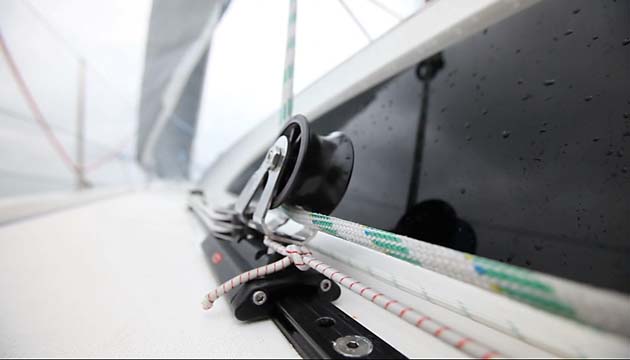
Traveller to windward:
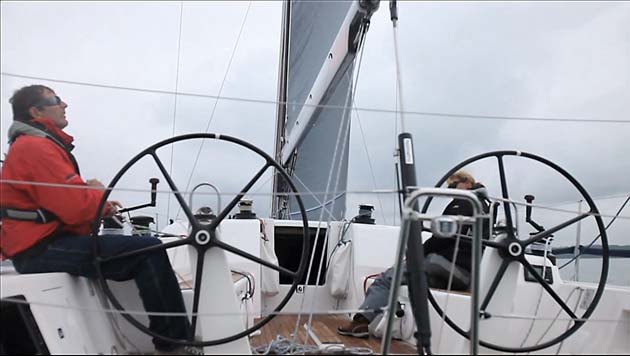
Ease jib halyard:
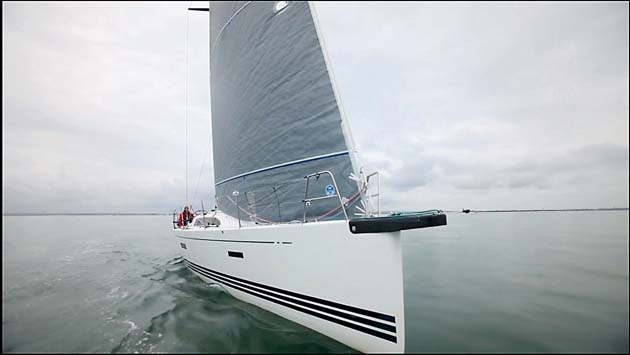
Ease outhaul:
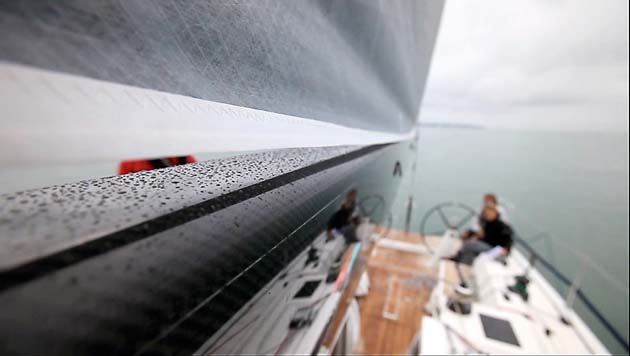
Downwind
Spinnakers
Light airs is where large lightweight spinnakers or cruising chutes come into their own. With asymmetric sails, ease the tackline to increase power in the sail. In a swell this may make the sail shape less stable, so pull it in again to strike a balance.
The pole on symmetrical spinnakers has a similar effect to the tackline. Moving the pole higher up the mast allows the whole sail to rise in the air for a fuller shape, but if the pole is too high, the windward clew will be suspended in the air while the rest of the sail sags over it. It is worth playing with the pole height to see what produces best results.
Change to light sheets if possible – any long piece of lightweight line will do – and keep easing the sheets. An over-sheeted spinnaker in light airs will be very slow.
Mainsail
If there is not enough wind pressure to keep the boom out in a swell then use a preventer to keep it in position. In very light conditions it is sometimes worth centring the main to allow a clean flow of air to the spinnaker, or even dropping it to stop excess flogging.
Steering
It is almost impossible and certainly not quick to sail a boat dead downwind in very light airs. In these conditions you will need to find your best downwind VMG by sailing the boat higher to increase the apparent wind and get the sail to fly.
Striking the balance between your course and speed downwind is the fastest way to reach your destination, but it usually involves gybing. If your instruments do not read VMG downwind, use the passage time to a GPS waypoint.
Autopilot
Autopilots really struggle in very light airs as they cannot react to the subtle changes in conditions and often drive the boat to a halt.
Do’s and don’ts
- DON’T give up as soon as the wind drops – trim the sails and persevere.
- DON’T try to point too high, and keep up power and momentum.
- DO change down to lightweight spinnaker sheets.
- DO make a note of light-wind settings for halyards, sheets and cars, so if the wind drops during the night, you can easily power the sails up.
- DO keep the boat moving; maintain speed first, then consider direction.
- DO walk gently around the boat, heavy movements will knock the air from the sails.
- DO use a preventer if necessary to keep the boom in position.
- DO hand steer and take pleasure from the fact that you are better than the pilot!
 Single-handed ocean sailor Pip Hare has clocked up thousands of miles racing and cruising. Among her achievements are five solo transatlantics, including the OSTAR and two Mini Transat races. She also works full-time for the RNLI on sea safety and is Consulting Editor on Yachting World. See also her series on short-handed sailing
Single-handed ocean sailor Pip Hare has clocked up thousands of miles racing and cruising. Among her achievements are five solo transatlantics, including the OSTAR and two Mini Transat races. She also works full-time for the RNLI on sea safety and is Consulting Editor on Yachting World. See also her series on short-handed sailing

Photo: Thierry Martinez
Brian Thompson is a vastly experienced sailor, who has raced solo and fully crewed round the world in monohulls and multihulls. His most recent record-breaking run was with Loïck Peyon aboard the trimaran Banque Populaire V, which sailed round the world in a breathtaking 43 days
SAIL FASTER SAIL SAFER Part 8: Pip Hare describes how best to set up your yacht for downwind sailing under white sails only
12 part series in association with Pantaenius




